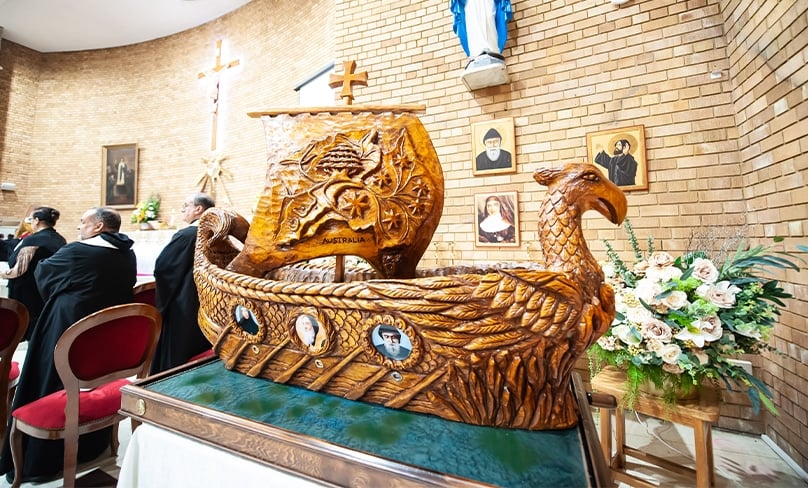
As the Maronite Eparchy of Australia celebrates its Golden Jubilee, the relics of St Maroun, St Charbel, St Rafqa, St Nematallah and St Mary MacKillop are visiting every Maronite parish in Australia. As we prepare for the visit of the relics, we can reflect on the lives of these great saints and all they have taught us.
Our beloved St Charbel has rightfully been an inspiration to many, and he is one of the many Maronite saints that we are blessed to have interceding for us and for our intentions. St Maroun, St Rafqa, St Nematallah and St Mary MacKillop all lived lives of prayer and deep devotion to Our Lord. No matter their journey to sainthood, the Maronite saints share commonalities for all Catholics to learn from: charity, obedience and suffering.
A holy virtue of the Catholic Church, charity is one of the many ways Catholics can fulfil the commandment of love. To do so, we can turn to the example of St Mary MacKillop and St Maroun.
Though not a Maronite Saint, St Mary of the Cross Mackillop is an important figure to Australian Catholics and she is much loved and revered by Maronites alike. Passionate about Catholic education, Mary Mackillop founded the Sisters of St Joseph, who established schools to educate poor children in rural areas.
She and the sisters encountered numerous difficulties in this time, living in poverty and relying on almsgiving and generosity. The work of the sisters also extended beyond schools, where they offered charitable works in remote and rural areas, establishing hospitals, shelters for the homeless and homes for the terminally ill and the elderly.
St Maroun lived his life as a healer of both bodies and souls. He was well-known in his lifetime, attracting many to the faith through his missionary work, where he constantly preached and spread the message of Christ across modern-day Lebanon and Syria. In his charity, St Maroun healed physical illnesses as well as spiritual illnesses, caring for “lost souls” with his examples of chastity, prayer and labour.
Holy obedience is another, and perhaps a more difficult, part of the Catholic faith. As Catholics, we are called to obey God, first and foremost, and in doing so, obey our religious leaders.
St Charbel is one of the saints who practised this, known for his life of simplicity. While in the monastery, St Charbel asked one of the brothers to refill his oil lamp which had run out while he was working in his room. Wanting to play a prank on St Charbel, the brother filled the lamp with water and brought it back to St Charbel, who was miraculously able to light it.
St Charbel actively denied himself in his lifetime and committed to his work in the monastery, asking his superior to give him the most difficult work and completing it without a single complaint.
Like St Charbel, St Nehmetallah was also known for his obedience. Upon taking his monastic vows, he lived a prayerful life and strictly adhered to religious rules. He valued obedience, seeing Christ in his superiors and following their orders with complete joy and submission—even when the order was to take a restful break from his theological studies.
Suffering is an unavoidable part of our lives, which might leave us questioning God and wondering why we are faced with difficult challenges.
St Rafqa was a nun who suffered immensely in her lifetime, not once complaining about it. She viewed suffering as a way to unite with Jesus and grow in her love of God.
When she joined the Lebanese Maronite Order, St Rafqa prayed for suffering, saying, “Do you want me, my Lord, to love you without suffering?” She then developed a painful condition which would eventually blind her and paralyse her completely.
She never complained, instead committing to her work in the convent as before and simply saying “in communion with Christ’s Passion,” whenever she suffered worsening pain or illness.
St Mary MacKillop and our Maronite saints are all examples of the deep love of Christ that we should strive towards as Catholics. Though we are not expected to go to the extreme lengths they went to in their journeys to sainthood, their commitment to charitable works, their humility and their sufferings teach us an important lesson of true Maronite spirituality – seeing Christ everywhere and constantly seeking opportunities to grow in love of God and neighbour.
As the relics of these great saints continue to make their way around Maronite parishes across Australia, may we learn from their examples and strive to live our lives in total dedication to Christ, as they did.
Vanessa Boumelhem is a former youth leader at St Raymond’s Maronite Parish and is in the final stages of a Bachelor of Communications (Writing and Publishing).
